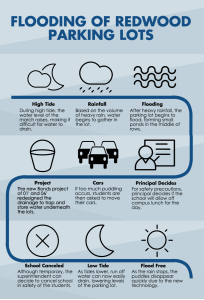Located on marsh land, the Redwood parking lots are infamous for flooding. Even with recent changes made to counteract flooding, the risk of inundation has increased due to the heavy hitting El Nino.
The storms started off non-existent in the beginning months of winter before eventually striking hard in December and the following months, according to the Marin Municipal Water District .
While Doherty Drive, the street surrounding Redwood on its north and east sides, had been equal to sea level in previous years, tides are rising, causing water to flood the streets, according to principal, David Sondheim.
“We’re very close to sea level, so as the tides go up there are less places for the water to run off and so it backs up more quickly,” said Sondheim. “Before Doherty Drive was redone, there would be water from street flooding, which was an issue as well.”

Before a Flood:
Hypothetically, effects of water damage are minimal as a storm first emerges. This year, the amount of rainfall needed to flood the lots was greater than that of previous years, according to Sondheim.
“After the reconstruction of Doherty Drive, the main flooding issues we have are when more rain falls than can drain out of the parking lots at any given time, usually based on the volume of rain and the tides,”said Sondheim.
After flooding several times, the school started to work on the Bonds project to install water catch basins underneath the school’s lots, which allowed for a large amount of water to drain and gather off the surface. They release the water as fast as they can to the ground underneath, yet the process is slowed down by the escaping high tide. Because of the high tides, water begins to puddle on the surface of the parking lots, mostly at the lowest points in the middle of the rows; this is where runoff drains are located, according to Sondheim.
“As part of the Bonds projects of 2001 and 2006, the parking lots’ ability to drain water was redesigned and reimplemented and has been much better since then. It has been a much less frequent occurrence.” Sondheim said.
Sophomore Carolyn French has dealt with issues related to flooding, as her house is prone to flooding.
“In general, technology has gotten better with the pipes outside and underneath our streets which helps out with drainage,” French said.
During a Flood:
When heavy rain begins to pour down, the principal and superintendent are obligated to consider more serious courses of action to keep students safe, according to Sondheim. Most commonly, students are asked to move their cars, and are sometimes obliged to stay on campus for lunch, rather than leaving for the 35 minutes.
“We had a storm a couple years back which was strong enough that we didn’t allow students to leave for lunch. Between the flooding of the lots and the danger of driving, we felt it was too unsafe for students to leave,” Sondheim explained.
In the recent storm on Jan. 18, it started raining during high tide. Puddles were slowly forming in the middle of the lots, eventually transitioning into foot-deep ponds, restricting cars from driving in the lot. If the rain had not let up, and the ponds kept growing, the school would have to consider closing campus for lunch, according to Sondheim.
In severe cases, the principal and superintendent are obligated to consider cancelling school for the day if conditions are too harsh.
“If the rains have been so bad the night before, the decision to cancel school is made by the superintendent and then we go from there,” Sondheim said.
In the seven years that Sondheim has been principal, the decision to cancel school has only been made twice.
After a Flood:
While school can only be closed due to extremely excessive rainfall, the process of flooding occurs often throughout the year. Once the tide has lowered, the water basins are able to release the water as fast as possible to gather any excess water settled on the surface of the lot, according to Sondheim.
Due to the current drought in California, rain has not been too big of an issue in past years, according to the Marin Municipal Water District.
“We’ve been going through a drought, and if anything, this year may be a bit on the heavy end, so we’ll know a little better after this year,” Sondheim said.
Once El Nino passes, the school’s ability to understand and manage flooding in the parking lots efficiently will increase drastically, according to Sondheim.











